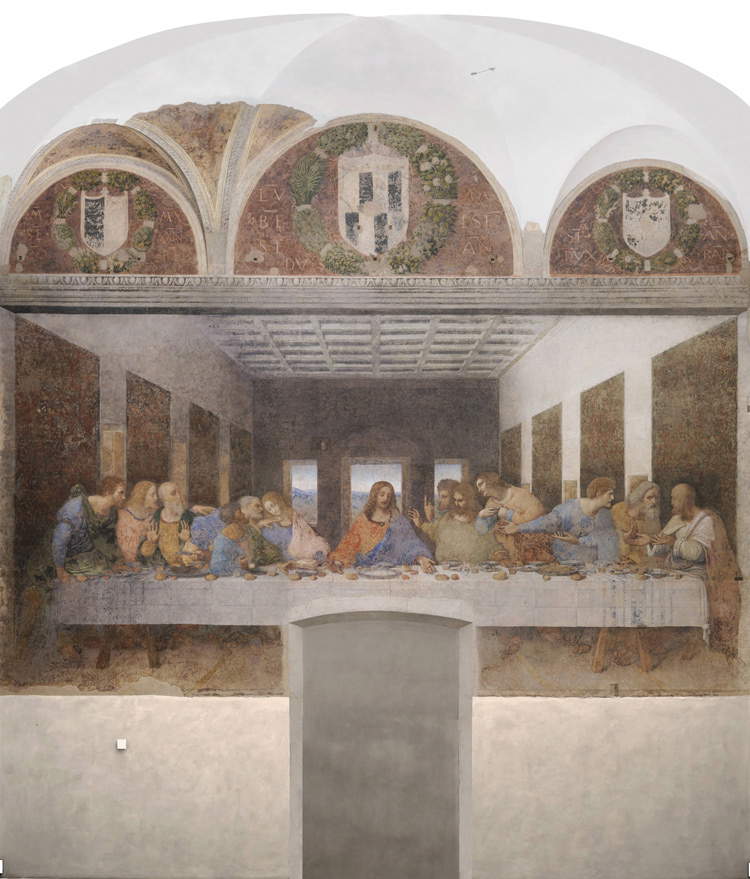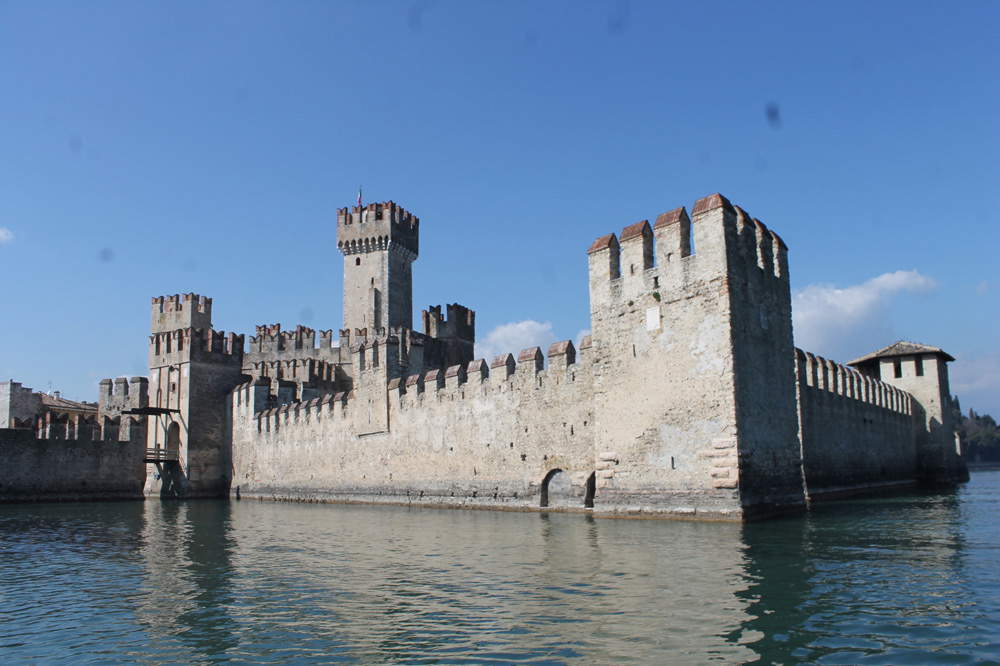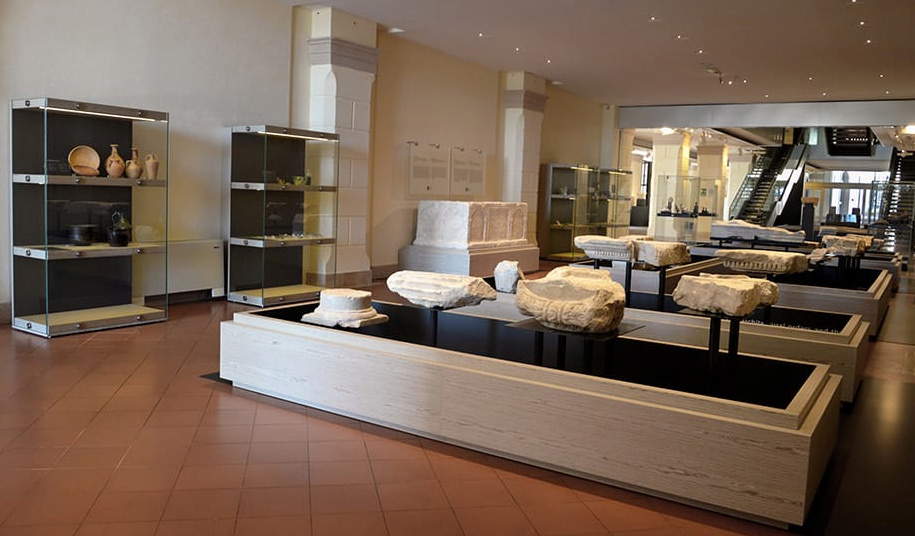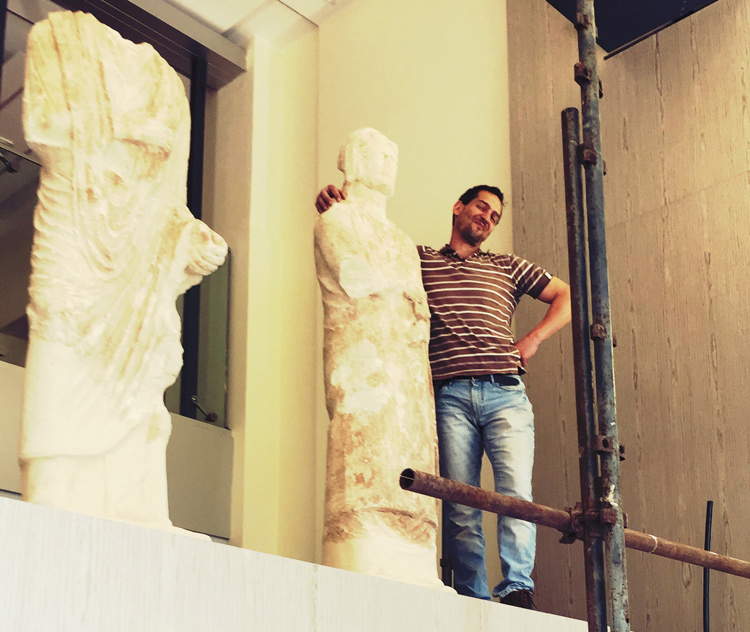The Polo Museale della Lombardia, an entity that brings together several museums in the region including some celebrated sites such as the Cenacolo vinciano, the Rocca Scaligera and the Grotte di Catullo in Sirmione, the Parco Nazionale delle Incisioni Rupestri di Naquane (the first UNESCO site in Italy) and the Museo della Certosa di Pavia, has experienced explosive growth in the last three years, marking a +15% increase in the number of visitors, and even a +69.8% increase in revenues. But that’s not all: numerous restorations, new layouts, the quality sponsorships that have focused everything on the concept of minimal bureaucracy for private individuals, and few exhibitions that have, however, focused on quality and collections. The interesting fact is that these results were achieved by having protection as a beacon, the real strategic axis to which good enhancement is closely linked. We met with the director who guided the Pole to the successes of these last three years, Stefano L’Occaso, whose term expired on October 31 this year (he had been in office since 2015). And we had him tell us how it was possible to achieve these remarkable results. The interview is by Federico Giannini, editor in chief of Finestre Sull’Arte.
FG. Dr. L’Occaso, your term as director of the Polo Museale della Lombardia ended on October 31 of this year. You had been in charge since 2015, and we could start the interview by talking about numbers, since visitors to the Polo’s museums went from 962,000 in 2015 to 1.1 million in 2017 (for 2018, of course, figures are not yet available). On the other hand, if we look at revenues, a near doubling has been sealed, since the 3 million and 600 thousand of 2015 has been raised to the 6 million and 100 thousand of 2017, and the outlook is still one of growth, since by mid-2018 the museums of the Pole had collected three and a half million euros. All in all, a very good result, which is moreover a choral result, because while it is true that most of the takings are concentrated on the Cenacolo Vinciano, it is also true that, more or less in the same proportions, almost all the other museums have also grown...
SL. Yes, we have done a group work, a choral work in fact, which has brought excellent results, of which we can be proud. We have almost doubled the revenue by focusing mainly on the ticketing of the Last Supper, but great increases in terms of revenue have come, for example, from Sirmione, where the Rocca Scaligera has exceeded one million euros in revenue both in 2017 and certainly in 2018. The increase in visitors will also be gradual during 2018 because we expect to arrive at least around 1.150 million: in November 2018 we equalized the result of 2017, with 1,103,995 visitors. As for the Cenacolo we should be around 420-430 thousand visitors, at the Rocca Scaligera with November we have already exceeded 300 thousand visitors, with the Grotte di Catullo that will follow closely. So, within the Pole, we should have three of the thirty most visited museums in Italy. In addition, the Pole is an institution that is in excellent health economically, and finally as of this year, with adequate staffing, it can afford to function and work at 100 percent. We can (must) also help less fortunate institutes.
Let’s focus on the Da Vinci Last Supper: it is a museum that, after all, makes about 60 percent of the Museum Pole’s income, so it is natural to give it attention first. Over the course of these years, a great deal of work has been done, from the opening of the new ticket office to the implementation of the emergency seismic monitoring system, from the creation of a new teaching room, a new bookshop and new toilets to the enhancement works, because the Cenacolo has a new logo, a new guidebook, there have been evening openings, and the opening of new digital communication channels. It can be said that good work has been done seeking that balance between protection and enhancement that has to be perfect for museums to function well....
I am convinced that valorization can only be a direct consequence of safeguarding actions. In three years I have not built any exhibition project, other than the one currently hosted at the Last Supper, with ten drawings by Leonardo from the British Royal Collections and displayed vis-à-vis in front of the work. Our work has mainly been to intervene in the facilities, security and thus the structure of the cultural sites we manage, assessing that if you offer a good quality service, making the sites found clean, tidy and safe, the tam tam effect of visitors may be enough to bring new users. This policy has been rewarded by numbers, perhaps also the result of chance, but in any case I can say that, at the end of my term, I leave the sites taken over in a certainly better state. Also from the point of view of restorations: we have carried out impressive campaigns, just think of the Rocca di Sirmione where we have redone something like five hundred square meters of flooring and already restored approximately two thousand square meters of plaster, and new contracts are starting for the northern elevation, and for the west side of the dock that was finally opened to the public in March 2018. In short, actions made to last and to allow those who will come after me to be able to be immediately operational without having to invest large sums on maintenance and preservation. We have also tried to avoid major restoration work by focusing, if anything, on planned maintenance, something we hear about very often, and which we have concretely implemented. And we have done all this in a great shortage of staff: until the end of 2017, the Polo Museale della Lombardia operated under conditions of absolute emergency, and only since 2018, with the conclusion of the competition for the five hundred new officials, has there been a sort of meiosis of the institute’s staff. Until then, we had to tighten our belts and work very hard also to become a contracting station and to start a series of tenders adjusting to a regulation that is not at all easy to manage, but always with excellent results. Among the first museums in Italy and even before many autonomous museums, we also initiated with Consip the tender for the concession of the Cenacolo’s additional services, which is a tender with a 29 million euro tender base, for which unfortunately we still do not have an award.
 |
| Leonardo da Vinci’sLast Supper |
We talked about investment and restoration. One of the aspects for which the Last Supper has distinguished itself is the new sponsorships, above all that of Eataly, which also ended up on the front pages of the non-specialized press. Obviously, the name of Leonardo has played in favor of the sponsorship, which we can consider a sort of brand on a par with that of a large company. However, this is a result that is far from being taken for granted, since Italy is still behind other countries in its ability to attract sponsorships, donations and private investments in the field of cultural heritage. In this sense, what is the work that has been done by the Polo Museale della Lombardia to activate this fruitful public-private partnership?
What I can somewhat boast of is that I have managed to concretize good intentions, because we know that the private sector very often gets scared when it has to interact with the heavy lifting of a public entity. What I have tried to do is to minimize the impact of bureaucracy for the private party and to make everything smooth, solving upstream every administrative problem, so basically providing for every form of public expression of interest, for calls for tenders, for everything related to transparency and publicity for these sponsorships: we took care of that directly, making sure that the private party got to the net the possibility of entering into a contract, without suffering the ordeal of a very complex bureaucracy and a particularly extensive and not always easy to interpret legislation. This has brought income to the Pole, over the three-year period, close to one million euros, because Eataly’s sponsorship alone is 680,000 euros. In addition to this, there have been several other enhancement agreements, spent mainly on restoration and plant works but also to expand the usability of the museums: an aspect to which I have cared a great deal and on which I have found great cooperation from the Museums’ reception and security staff, has been the attempt to improve every service, that is, to have the museums always found open and to expand the opening hours of the sites. In Sirmione, which experiences an extraordinary tourist season in the summer, we have managed, for two years in a row, to keep both museums open seven days a week from June to September, thus giving as much availability as possible to tourists. This has been a big sacrifice for the staff, however, the balance has been found with the unions, and this has also allowed us to bring substantial extra income to the institute.
Remaining on the Cenacle, His leadership was also marked by the strike of the staff who, last April, crossed their arms to demand guarantees of work continuity in view of the renewal of the contract for the concession of services. It was, moreover, the second time in two years that Cenacolo workers went on strike, and two years earlier it had also happened in other museums in the Pole. And these were scenes that we have seen happen with some frequency throughout Italy in recent years. In your opinion, is enough being done in the cultural heritage sector to protect workers’ rights?
The civil servant is certainly very well protected. In our specific case there was an agitation over the application of the social clause in the call for tenders run by Consip for the concession of additional services, but the limits of the application of the social clause have been well defined by numerous rulings of the Tar and the Council of State, and we have adhered to these indications, which also protect the organizational freedom of the subrecipient company; this is necessarily also a constraint on the social clause, which cannot be applied in an excessively restrictive way. There was, indeed, also a strike in April 2016, which led to the closure of the Cenacle for a day, given the inapplication of the Colosseum Decree, but in that specific case the unions (I remember it very precisely) did not want to enter into the agreement for the guarantee of minimum services, which we proposed, albeit at the last second, because we were not warned in a timely manner by the competent bodies.
 |
| The Rocca Scaligera of Sirmione |
Let us move from Milan to Mantua: You are very familiar with the Ducal Palace, since you arrived at the Superintendency in Mantua in 2000, you were for almost a year interim director of the Ducal Palace Museum in 2011 and then covered this position again in 2017 during the period of Peter Assmann’s suspension following the now famous appeal against the Ministry, and for a year and a half, between 2014 and 2015, you were director of the Castle of San Giorgio. Mantua is a truly singular reality because, in a city that does not even have 50,000 inhabitants we have an autonomous museum, Palazzo Ducale, we have a museum that belongs to the state, which is the Archaeological Museum, which until May 2018 was part of the Pole that you directed and which then became part of the Palazzo Ducale complex, there are the civic museums such as Palazzo Te and San Sebastiano, there is the diocesan museum, there are the private museums such as Palazzo d’Arco, and moreover they are all museums of great importance. How is it possible to keep such different realities together?
It is not very easy: moreover, it is one of the tasks of the director of the Polo Museale della Lombardia, but I admit that it is not always easy to reach understandings. Actually, as far as Mantua is concerned, agreements are already there, because we have a card for the museums of Mantua, which allows entry to the entire circuit of the city’s museums, there are joint ticketing agreements that go back several years, because already on the occasion of the exhibition on the Gonzaga tapestries in 2010 a single ticketing between Palazzo Te and Palazzo Ducale was experimented, and then there are different forms of collaboration. Personally, I hope that we will be able to arrive at a unified vision for the Giulio Romano exhibition planned for 2019. However, it must be said that the state cannot get more into the merits of the choices of local authorities or private individuals, and vice versa, so in addition to looking for forms of coordination that already exist (because there are tables at which choices and management policies can be shared), it remains in some ways necessary to safeguard the freedoms of individual institutions.
And still in Mantua, you have really done a great job with the National Archaeological Museum....
A museum that by the way is no longer part of the Polo Museale della Lombardia, because in May of this year, with Decree 88 of 2018, we handed it over to Peter Assmann to become part of the Palazzo Ducale complex. And that was after doing a lot of work: I took it that was a room and now it’s a museum. We restored the frescoes in the entrance vault, turned the blind end of the ground floor into a panoramic view of the lakefront, restored dozens, maybe hundreds of artifacts, designed and built the whole first floor and second floor layout. For me it was a great satisfaction: I have lived in Mantua for eighteen years (I came of age in September!) and so for me these interventions were a pleasure, as well as a civic duty. So we handed over the now-ready museum to Assmann with extraordinary growth numbers (it has gone from 4,000 to 17,000 visitors in two years) so that it could become part of a single complex: a sacrosanct choice, because in a unified management the museum will be able to open up to the very large public of the Ducal Palace.
But there are more than just numbers, or plans for new displays, restoration and maintenance. The National Archaeological Museum of Mantua has also experienced various enhancement projects: in particular, there have been several exhibitions of various kinds, between those aimed at promoting the culture of the area and those that, for example, have brought contemporary art into the archaeological museum. What do you think is the formula for organizing, in a medium-sized context such as the National Archaeological Museum of Mantua, quality exhibitions that do not take over the museum?
This is a big problem. I have never been an enthusiast for contemporary art exhibitions within state sites, always seeing a danger of conflict of interest, of potential commercialization of what is displayed within the museum. The same then applies to works from private collections. I have always been very attentive to this aspect. In the case of the National Archaeological Museum in Mantua, we have combined the two different experiences, that is, we have done exhibitions with fairly small budgets but with a strong ethical and public charge, such as the 2016 exhibition Saving Memory, which was about saving heritage after dramatic events such as wars or earthquakes, just as we also welcomed contemporary art exhibitions, which served more to draw public attention to a container that was empty at the time. Therefore, in the planning and implementation phase of the installation work, and already envisioning the recovery of archaeological materials from the deposits and their display within an architecturally interesting volume, we thought that we could somehow draw the public in by bringing them to see even exhibitions with themes that were sometimes completely disjointed from the container. It is something, however, that in other contexts such as Sirmione or the Cenacolo vinciano I did not want to accommodate: in this case the return to the public administration would hardly have been adequate and proportional compared to the benefit that a collector or an artist might have by exhibiting his works within these sites.
The Polo Museale has also engaged to a certain extent on the enhancement front with realities that do not belong to the world of culture, for example, for 2017 in Sirmione an agreement was signed with the Consortium of Hoteliers and Restaurateurs to guarantee an increase in the Sunday museum offer of the Rocca Scaligera and the Grotte di Catullo, and in addition a proposal for single ticketing in Milan has been put forward that would connect the Last Supper, Castello Sforzesco and Brera, moreover three museums that belong to three different entities: is enough being done in your opinion to bring the various institutions closer to each other, and to bring museums closer to other areas?
Not always enough is done, but not in all realities is it easy to involve the private sector. In Sirmione this aspect has been addressed and has brought excellent results because this very collaborative relationship has allowed for the extension of museum hours, so if in 2015 on Sundays the Rocca closed at lunchtime, thanks to this agreement we made it possible for it to stay open until six in the afternoon in the summertime. It was important from the point of view of revenue but especially in terms of public service-I believe that a state-run cultural site should be open and visitable first and foremost.
 |
| The National Archaeological Museum in Mantua |
 |
| Stefano L’Occaso during set-up work at the National Archaeological Museum in Mantua |
You, besides being an art historian, are also a restorer, with several experiences on important works to your credit. Yours is therefore a special case because it is very difficult for a museum director to be both an art historian and a restorer: what kind of sensitivity guarantees being both figures at the same time, and how has it oriented your work in recent years?
This characteristic has definitely directed my work, it is part of my personality and pushes me to be instinctively more inclined to protection than to valorization: that is why I have focused on protection as a form of valorization. Having said that, specific experience in restoration certainly is a very useful tool because it allows you to get into the merits of restoration choices and then the planning of all the necessary interventions within our sites. There is to be said that actually, for a manager, this aspect should not be decisive, because a manager today is mainly called upon to lead, particularly in the case of the Polo Museale della Lombardia, a complex administrative and management machine, and therefore a large accounting and bureaucratic architecture, rather than entering into the merits of individual technical choices. It is obvious, however, that this helps: I still believe that in order to run a MiBAC institution, one must be very clear about the main objective, which is the protection of the property. We can have very good managers who can teach us so much about communication and every other management aspect: the fact remains that I don’t think we can separate the governance of the cultural asset from the knowledge of the artifact and therefore from an approach in terms of protection towards the artifact itself. The risk would otherwise be that we would approach a museum or an archaeological site as a neutral place, and we absolutely must avert that risk. So I think it is correct that in the ranks of the ministry’s managers there are people who have acquired specific experience in terms of cultural heritage management, as much as, I reiterate, I have so much to learn about enhancement, communication, managerial management. I think a more fruitful dialogue can only be an ideal key for the future.
And, indeed, a field on which perhaps we need to have a more managerial approach, and a field for which we often complain about the shortcomings manifested by Italian museums, is precisely that of communication, especially if we think about digital media, web and social presence and whatnot. What kind of attention have you paid during your tenure to the topic of communication? And what needs to be done to improve in Italy?
We have some very good examples even in the museum field, here in Milan just look at the work done in Brera on communication, which is certainly exemplary from this point of view or, for education, the wonderful Museum of Science and Technology. The general direction of museums, in the person of director Antonio Lampis, is pressing hard to improve in aspects of communication. I must confess that, especially in the first two years of my directorship, partly because of staff shortages, partly because of the need to solve structural problems, I devoted much more attention to these aspects than to communication. Today, on the other hand, we have an adequate staff, we have an awareness of what we have to do, and so we are off to a good start: we are launching a new website, we are getting accredited on social media, we have started talking directly with newspapers by creating a small press office, and we have managed the exhibition of Leonardo’s drawings without contracting to external communications companies, precisely to force us to grow in this area. Much remains to be done, but in Rome the General Directorate of Museums is creating the tools for growth through continuous moments of discussion.
What awaits the Polo Museale della Lombardia in the future, what unresolved problems, what to do to improve further?
Meanwhile, the Polo awaits a call for applications so that a tenured manager can be appointed to whom I can hand over and somehow ferry the experience of this particularly intense and complex three-year period. There is work to be done on communication, there is still work to be done against bagging in the Museums, there is also work to be done on enhancement with projects that are possibly built from within and not purchased as prefabricated packages: we have the skills and the staff that can deal with all the aspects necessary for enhancement, because we have architects, archaeologists, art historians, communication functionaries. Right now the Polo Museale della Lombardia is an institution in full health and with a fair number of staff: we have shortages in the profile of the administrative staff, as well as serious shortages on the museum supervisory staff, but the central structure of Palazzo Litta is ready to work on any project.
In conclusion, what are your future plans?
I am in the service of the state, so I am ready to work under any circumstances that may be deemed useful and, like water, I always find my way.
Warning: the translation into English of the original Italian article was created using automatic tools. We undertake to review all articles, but we do not guarantee the total absence of inaccuracies in the translation due to the program. You can find the original by clicking on the ITA button. If you find any mistake,please contact us.